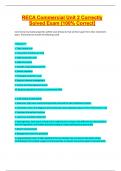RECA Commercial Unit 2 Correctly
Solved Exam [100% Correct]
Commercial real estate properties exhibit several features that set them apart from other investment
types. These features include the following: (x10)
**Answer:**
1. They involve land
2. Transaction timelines are long
3. High transaction costs
4. Expensive assets
5. Durable, long-lasting properties
6. Heavily regulated
7. Prolonged production cycle
8. Require intensive management
9. Unique and heterogeneous assets
10. Require evaluation of return on investment (ROI)
1. Long-lasting, durable goods
2. Expensive, high-value investments generally reserved for well-capitalized investors
3. Transaction Costs: Due diligence and commissions alone typically make up 3-5% of transaction costs
4. Extended transaction timelines
5. Land as an essential component
6. Heterogeneity: Each parcel of land and its related asset is unique, with different site characteristics,
land use regulations, and market demands leading to unique development approaches
7. Return measurements
8. Management-intensive operations
9. Long production cycle: It takes significant time to develop new commercial real estate assets,
contributing to the inelastic supply of such properties, as they do not quickly adjust to demand shifts
,10. Highly regulated market
**Inelastic Supply**
**Answer:** There is a restricted supply. For example, many cities face geographic limitations and
zoning laws that control how land is used. This results in a relatively inelastic supply of commercial land,
meaning the supply cannot easily adjust to changes in demand or price.
**Four major commercial real estate asset types as per Real Capital Analytics:**
**Answer:**
1. **Office**: Real estate primarily used for office space
2. **Retail**: Properties like strip centers, neighborhood malls, community centers, and large regional
shopping malls
3. **Industrial**: Real estate intended for industrial purposes, including warehouses, distribution
centers, manufacturing plants, and data centers
4. **Apartment**: Multi-family rental properties
Other miscellaneous product types include hotels, leisure (e.g., golf courses), and special use (e.g.,
casinos).
**Three miscellaneous product types:**
**Answer:** Hotels, leisure (e.g., golf courses), and special use (e.g., casinos).
**Categorization by Building Class:**
**Answer:** For instance, office buildings are often classified as Class A, B, or C.
**Categorization by Number of Storeys:**
**Answer:** Apartment buildings can be classified as garden complexes (low-rise buildings of four
stories or less) or mid/high-rise projects (four stories or more).
**Categorization by Property Location:**
,**Answer:** Office buildings are often categorized based on location, such as central business district
(CBD) or suburban areas.
**Categorization by Type of Building:**
**Answer:** The International Council of Shopping Centres (ICSC) classifies shopping centers by size
(gross leasable area and land area), tenant types, and trade area.
The duration of the Commercial Real Estate Asset Life Cycle varies significantly depending on various
factors, including: (x5)
**Answer:**
1. The product type of the real estate asset
2. The size and complexity of the project
3. The regulatory environment
4. The need for related infrastructure
5. The financial and operational capability of the investor(s)
A typical commercial real estate asset experiences three phases throughout its life cycle:
**Answer:**
Phase I: Land Acquisition and Development
Phase II: Building Construction
Phase III: Operations and Asset Management
**Phase I: Land Acquisition and Development:**
During Phase I, the developer secures the land and undertakes essential development and pre-
construction activities, including: (x3)
**Answer:**
1. Conducting a feasibility analysis
, 2. Engaging the services of planning experts, architects, engineers, contractors, and marketing
professionals
Soliciting capital providers (e.g. investors, lenders)
True or False - With the exception of a multi-family project, usually some pre-leasing must be in place.
**Ans**True - Capital providers often require pre-leasing, which involves obtaining lease commitments
in advance of construction. In fact, a construction lender may not commit construction funds until there
are leasing commitments for a certain percentage of the space. With the exception of a multi-family
project, usually some pre-leasing must be in place. Once lease up of the rest of the asset is complete (i.e.
full occupancy), most of the risk associated with the development is eliminated.
Four professional organizations that represent both property management and asset management
professionals. **Ans**Building Owners and Managers Association (BOMA)
Institute of Real Estate Management (IREM)
National Council of Real Estate Investment Fiduciaries (NCREIF)
Real Property Association of Canada (REALpac)
True or False - In the process of operating and maintaining a real estate asset, the property manager is
responsible first to the tenant **Ans**False - In the process of operating and maintaining a real estate
asset, the property manager is responsible first to the investor and second to the tenants. The property
manager is expected to follow the investor's lawful instructions.
Asset Management **Ans**The property manager typically reports to the asset manager. Asset
management involves maximizing the value of a real estate asset or a portfolio of real estate assets
according to the objectives defined by the investor. Different investors have different objectives and
maximizing value may only be one of them.
The property manager provides the following reporting: monthly (x3) , Annually (x3), for the purpose of
(x3) **Ans**Monthly:
Accounting
Operations




